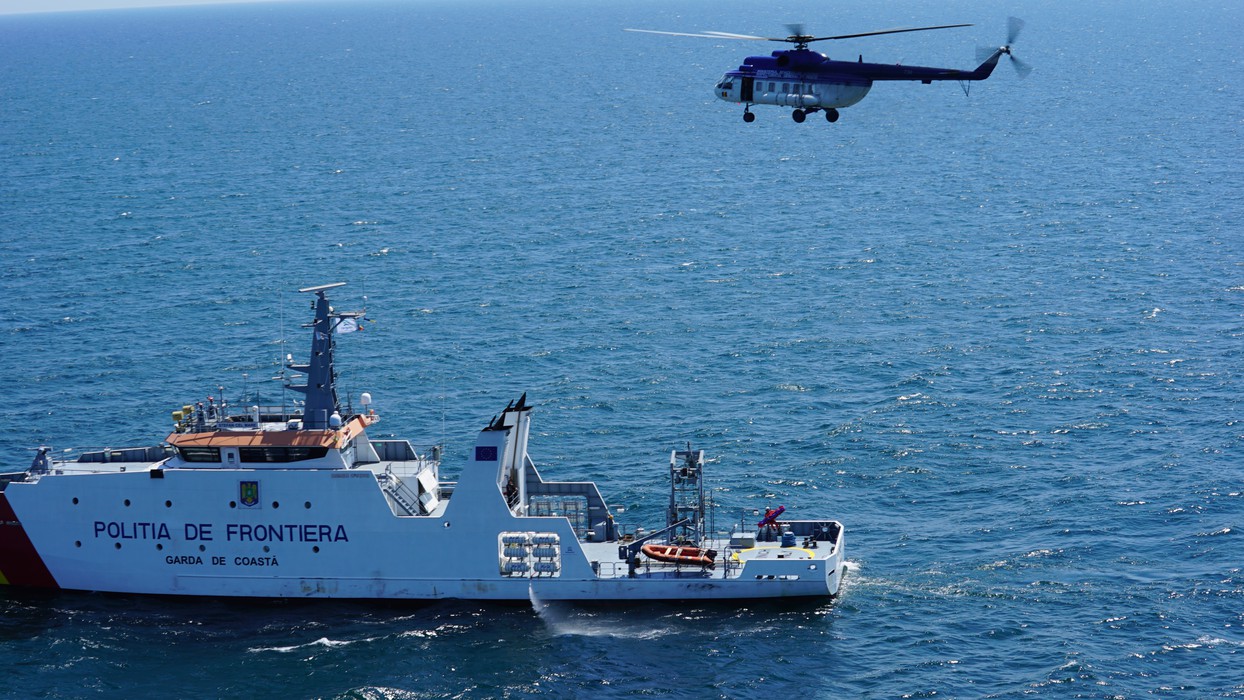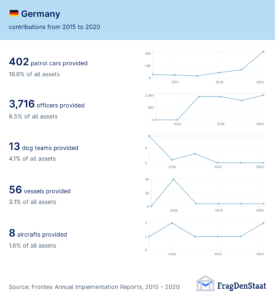756 German officers, 11 Italian aircrafts, 62 Bulgarian patrol cars, 101 Austrian deportation officials… European states’ contributions to Frontex keep the EU border regime in place.
EU border police Frontex carries out border control operations by land, sea and air. Yet the backbone of Frontex’s work – the equipment and officers that implement and make Frontex operations possible – doesn’t belong to the EU border agency, but are contributions from European countries.
Every year, all EU Member States – as well as a series of non-EU countries, including Switzerland, Iceland and Norway – pledge and transfer resources and equipment to Frontex for its operations.
These resources are both technical and human. They include the assets Frontex uses, such as patrol boats, helicopters, aircrafts, cars and vans; smaller equipment such as CO2 and heartbeat detectors; as well as officers who participate and, in fact, implement Frontex’s border control and deportation operations.
Frontex’s heavily increased budget will allow it to purchase more of its own equipment in the coming years, but for now its ability to carry out border operations and deportations is heavily dependent on European countries’ solidarity with the agency. In 2020, national contributions accounted for over 80% of all of the equipment used in Frontex operations. When it comes to bigger equipment such as vessels and aircrafts, countries provided 98% of the assets used by Frontex.
In order to better understand each European country’s contributions to Frontex, NGO FragDenStaat has published a compilation of all resources (equipment and officers) made available to Frontex per country, from 2015 to 2021.
Who contributes what: an Europe-wide effort towards Frontex
Every EU country makes contributions to Frontex operations, whether it’s officers, equipment or both.
The type of resources countries put at Frontex’s disposal are often dependent on whether a country is the host of a Frontex operation: for instance, Italy (which hosts Frontex’s Operation Themis in the Central Mediterranean) is a heavy contributor of maritime-oriented assets such as vessels and patrol boats. Meanwhile, countries which are not part of the so-called frontline states, make contributions in order to compensate or complement those of border states.
When it comes to vessels and patrol boats, Italy, Greece, Spain and Romania are Frontex’s strongest providers. For aircrafts and helicopters, Frontex relies heavily on Italy. Germany is Frontex’s main provider of patrol cars to Frontex along with other EU states such as Poland, Hungary and Bulgaria.
When it comes to what Frontex calls its “boots on the ground” (the officers deployed in charge or executing Frontex’s border control tasks), we find a heavy reliance on Greek, German and Italian officers. Meanwhile, deportations coordinated and executed by Frontex are mostly handled by officers contributed from Austria and the Netherlands.
A full overview of each country’s contributions to Frontex from 2015 to 2021 is available here.
Why (ending) countries’ contributions to Frontex matter
Over the past years, multiple investigations have exposed Frontex as a violent actor: wherever it is deployed, it enables and contributes to violence against people at the EU’s borders.
Frontex has been implicated in numerous and continuous human rights violations, yet this has not, to date, altered European countries’ continued support towards the agency. This is in spite of the fact that, ultimately, it is countries’ resources what make these violations possible.
The vessels and boats from which pushbacks are conducted in the Aegean have been made available to Frontex by Romania and Portugal. The officers who mistreat and push back people throughout the Balkans are very often identified as German speakers.
Yet as most states continue to pledge material and human support to Frontex without questioning the implications this might have and the complicity it creates, some European countries have started questioning whether they should be putting their resources at the service of such a violent border regime and agency.
This is the case of Switzerland, which on 15 May will hold a referendum – the first of its kind – on whether to withdraw its support to Frontex. As a non-EU state, Switzerland not only contributes resources and officers to Frontex, but also money: 61 million Swiss francs per year in 2027.
At the heart of Switzerland’s vote lies an important reality the rest of European states must also confront: as long as countries keep contributing resources to Frontex, these resources will be used to perpetrate and enable violence against people on the move.
To this extent, putting an end to national contributions to Frontex is not only a way to take a stance against the ongoing violence at Europe’s borders; it is in fact a decisive step towards actually ending this violence by refusing to actively participate in it.
Ending countries’ contributions to Frontex is therefore a central measure towards abolishing Frontex, putting an end to the EU border regime, and enabling us to invest valuable resources into policies that protect – instead of endangering – lives.
How and when contributions to Frontex are agreed by European countriesHow many resources (assets, technical equipment and officers) European countries make available to Frontex for its operations stems from two rounds of negotiations held between each country and Frontex every year. Twice a year (in the spring and at the end of the summer), Frontex makes an estimation of how many resources it will need in order to be able to carry out its operations. On the basis of this estimation, Frontex reaches out to all European countries and makes a request for their contributions. Negotiations are then held between countries and Frontex, where both agree how many resources will be made available to Frontex when. For some equipment, mainly patrol vessels, which member states have bought with EU funding (from the Internal Security Fund or the Integrated Border Management Fund), there exists an obligation to make it available to Frontex for a part of each year. The resources agreed as a result of these negotiations will be incorporated into Frontex’s “pool” of resources: from then on, they become available to Frontex, which can then deploy them during its operations. Occasionally, Frontex will run short of equipment or officers and can request additional contributions from countries. On other occasions, Frontex will choose not to deploy the resources in its “pool”, even if they are at their disposal. |





